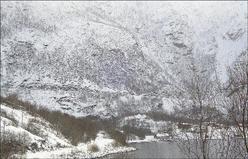Barbara Ellington, Lifestyle Editor


Left: It is now winter but come summer, the sun shines all day over Norway. Right: There are many picture-perfect places like this in the south of Norway.
It has been my most fascinating assignment to date but also the most gruelling. Svein Wara, marketing manager of the Norwegian Seafood Export Council, invited three members of the Jamaican media to Norway for an in-depth look at the fishing industry and he packed activity into every waking hour of the day. Hopefully, by the time all the tales of Norway are told, Jamaicans will buy lots more salted saithe (we call it salt fish), and learn to cook it in 1,001 ways like the folks in Portugal.
The team of four departed Kingston for Norway on March 1 and returned after 11 flight changes on March 8. The first destination, Rost, was finally accomplished on Sunday night after stops in London, Oslo and Bodoe, the latter leg aboard a 19-seater charter plane. By then, it was snowing heavily. Being terrified of small planes, I was not reassured to see the rather elderly pilot but thought surely, he's experienced and could do this blindfolded. Plus, it was only 30 minutes long.
Accommodation
Our accommodation was a fishing lodge, the room had the basic comforts, particularly hot water, but there was no CNN among the television channels and with seven below zero outside, I imagined a long night ahead. To compound matters, the heater barely kept things warm. So after close to two days' travel, one expected a shower and much-needed sleep. Wrong. Wara and the other hosts had a meet-and-greet session plus dinner laid out.
That day's freshly caught cod was lightly boiled and served with a butter sauce; with boiled potatoes, cod liver and cod roe. Surprisingly, very delicious and everyone had seconds. This is the traditional Christmas Eve meal. Norway's Aquavit (white rum is still the king) and beer was paired with the meal. Other members of the delegation included magazine, television and newspaper journalists from Greece, Portugal and Norway. (See more details in our upcoming Food sections.)
On Monday morning, we set out to explore the tiny island that is home to 632 residents. Apart from being extremely cold (just three hours from the North Pole), wind speeds exceed 70 miles an hour. It will whip you away if you are careless, (it took my hat 100 yards in less than a minute). To face it, we had to wear specially insulated gear that made us look like astronauts.
The trip to fishing locations at sea was aborted because of very rough seas. As waves crashed to shore, I imagined what they would have done to a boat. On the tour, we saw areas where sheep once grazed in abundance and potatoes were planted. A few friendly sheep came up for a photo opportunity.
It was interesting to see how cod was hung over logs to dry in the frigid temperature. After four months, it is exported to Italy, the main market for unsalted, dried fish. It regains its weight by four times when placed in water. The heads (quite ordinary fish head), were dried and exported to parts of Africa.
Rost has schools, a church built in 1900, an activity hall, a small supermarket, an administration centre and a town hall. The fish factories are in the south of the island and fish-farming is the mainstay. Potatoes are no longer planted.
Cod-processing factory
The next stop was at a cod-processing factory - Glea and Lofoten - managed by Olav Johan Petersen. From the boats, fish are mechanically transferred to huge containers where men remove the heads, roe and liver, wash and load in huge plastic containers and send to another facility for salting and drying. Young Dennis and Preben deftly remove the tongues from the cods' heads.
The tongues are a delicacy and are served breaded and fried. The young boys vie for the enviable job that earns them US$9.00 per hour and they cut up to 20 kilos per hour. Preben loves his job he has bought himself quite a few electronic gadgets with his earnings.
Tuesday's scheduled helicopter ride to Inndyr is aborted by, you guessed, bad weather.
By bus, we rode along entirely snow-covered roads. The scenery along the residential areas and mountains is exactly as depicted on Christmas cards from far-off lands. We go through underwater tunnels too and toll rates are high (US$12).
Whales frolicking
We are lucky to spot whales frolicking in the fjords and at Natmarine Cod Aquaculture Farm located at the south. It's yet another session for suiting up in warmer clothing for a boat trip to see how cod is grown out of giant-size cages. We counted 10 cod cages and the fish juveniles come in from west Norway at 100 grams weight. Students come here to learn about the fishing industry.
At a desired slaughter weight of two-three and a half kilos, the fish are reaped. This takes approximately two years and they are fed at five-second intervals every minute for four hours daily but a little less when they are bigger. To keep the pens clean and sanitary, sediment and excrement tests are done regularly and pens are rotated. In 2007, 82 tons were exported from this location and for this year, 86 tons are projected for export.
(To be continued.)

Journalists head out to Natmarine Cod Aquaculture Farm.
- photos by Barbara Ellington

Alesund fades in the distance.

The cemetery at Rost.

This is how fresh cod is hung to dry in the frigid air on the island of Rost in Norway.
NORWAY FACTS
Norwegian children start to learn English at age nine but many are now opting to learn a third and fourth) language (French or Spanish).
There are no cops on Rost which is crime free. If there is a violent domestic dispute, neighbours go in to quell things but if that fails, they send to Bodo for help.
It's five US dollars to one Krona and cost of living is very high but salaries are good. There is not much difference between what teachers, cops or garbage collectors make. So a pack of gum costs J$500 and a cup of tea/coffee costs US$4.00.
Cod roe is also used to make caviar.
Some 800,000 kilos of cod liver oil are exported from one factory each year.
Norway earns most of its income from oil and natural gas but fishing also accounts for a large portion of the revenue.
Barbara Ellington's trip to Norway was made possible by the Norwegian Seafood Export Council in association with its local representative, ProCom.

